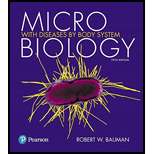
Microbiology with Diseases by Body System Plus Mastering Microbiology with Pearson eText -- Access Card Package (5th Edition)
5th Edition
ISBN: 9780134452333
Author: Robert W. Bauman Ph.D.
Publisher: PEARSON
expand_more
expand_more
format_list_bulleted
Concept explainers
Question
Chapter 19, Problem 3CT
Summary Introduction
To determine:
The things which can be looked when attempting to distinguish the subcutaneous mycoses caused by
Introduction:
Mycoses are fungal infections of skin, nails or hair. There are plenty of physiological and environmental factors which are responsible for the fungal diseases. Persistent infection might be initiated by the inhalation or localized colonization of skin by fungi and their spores. Mycoses are classified as superficial, subcutaneous and systemic. Most of the mycoses causing fungi are opportunistic.
Expert Solution & Answer
Want to see the full answer?
Check out a sample textbook solution
Students have asked these similar questions
What do you know about subcutaneous mycoses? explain any one fungus with clinical features and special lab findings?
Many fungal infections of humans are considered to be opportunistic, meaning that fungi that are normally free-living (usually in soil) can sometimes survive, and even thrive, on or inside the human body. From the fungal “point of view,” what unique challenges would be encountered when trying to survive on human skin? What about inside human lungs?
More fungal diseases are recognized than were known just a decade ago. For example, in 2012, hundreds of patients developed a meningitis caused by a fungus never before known to cause disease. Why is this the case? Why are mycoses among the most difficult diseases to treat?
Chapter 19 Solutions
Microbiology with Diseases by Body System Plus Mastering Microbiology with Pearson eText -- Access Card Package (5th Edition)
Ch. 19 - Prob. 1TMWCh. 19 - Prob. 2TMWCh. 19 - Buruli Ulcer Jacques liked living in the...Ch. 19 - A New Cause of Spots Fifty-two-year-old David has...Ch. 19 - Prob. 3TMWCh. 19 - A Painful Rash A mother brings her three-year-old...Ch. 19 - A Child with Warts Ten-year-old Rudy has several...Ch. 19 - Grandfathers Shingles The Davises were excited...Ch. 19 - Prob. 4TMWCh. 19 - Prob. 4CCS
Ch. 19 - Prob. 5TMWCh. 19 - Diagnosis in the Desert In the 1970s,...Ch. 19 - Prob. 6TMWCh. 19 - Prob. 3EDCSCh. 19 - The epidermis ____. a. has an intricate network of...Ch. 19 - Prob. 2MCCh. 19 - Prob. 3MCCh. 19 - Prob. 4MCCh. 19 - Prob. 5MCCh. 19 - Prob. 6MCCh. 19 - Prob. 7MCCh. 19 - Prob. 8MCCh. 19 - Prob. 9MCCh. 19 - Prob. 10MCCh. 19 - Prob. 11MCCh. 19 - Prob. 12MCCh. 19 - Prob. 13MCCh. 19 - Prob. 14MCCh. 19 - Prob. 15MCCh. 19 - Prob. 1MCh. 19 - Prob. 1FIBCh. 19 - Prob. 2FIBCh. 19 - Prob. 3FIBCh. 19 - Prob. 4FIBCh. 19 - Prob. 5FIBCh. 19 - Prob. 6FIBCh. 19 - Prob. 7FIBCh. 19 - Prob. 8FIBCh. 19 - Prob. 9FIBCh. 19 - Most pimples result from infection by ______ not...Ch. 19 - Prob. 1MTFCh. 19 - Prob. 2MTFCh. 19 - Prob. 3MTFCh. 19 - Prob. 4MTFCh. 19 - Prob. 5MTFCh. 19 - Prob. 1SACh. 19 - Prob. 2SACh. 19 - Considering that Pseudomonas aeruginosa and...Ch. 19 - Prob. 4SACh. 19 - Prob. 5SACh. 19 - Describe four enzymes produced by Staphylococcus,...Ch. 19 - Prob. 7SACh. 19 - Prob. 8SACh. 19 - Prob. 9SACh. 19 - Prob. 10SACh. 19 - Label each lesion seen in poxvirus infections.Ch. 19 - Prob. 2VICh. 19 - Prob. 3VICh. 19 - Prob. 1CTCh. 19 - Why is it more difficult to rid a community of a...Ch. 19 - Prob. 3CTCh. 19 - Prob. 4CTCh. 19 - Prob. 5CTCh. 19 - Most DNA viruses replicate within the nucleus of a...Ch. 19 - Prob. 7CTCh. 19 - Prob. 8CTCh. 19 - Prob. 9CTCh. 19 - Prob. 10CTCh. 19 - Prob. 11CTCh. 19 - Why do impetigo and erysipelas occur more commonly...Ch. 19 - Prob. 13CTCh. 19 - Prob. 14CTCh. 19 - Prob. 1CM
Knowledge Booster
Learn more about
Need a deep-dive on the concept behind this application? Look no further. Learn more about this topic, biology and related others by exploring similar questions and additional content below.Similar questions
- What features of the lungs make them a favorable site for fungalinfections?arrow_forwardWhy fungal infections are more difficult to treat compared to bacterial infection? Discuss at your own wordsarrow_forwardThe following are cultural characteristics of fungus causing subcutaneous mycoses except* majority of fungi causes superficial skin infections it usually occurs in tropical regions classification includes dimorphic fungi the infections are caused by saprophytic fungiarrow_forward
- A worker involved in demolishing an older downtown building is thevictim of a severe lung infection.a. Without any lab data, what two fungal infections do you suspect?b. What is your reasoning?c. How would you differentiate them?arrow_forwardWhat is the public health importance of Toxoplasma, and how do humans become infected with it? What is the public health importance of Cryptosporidium and Cyclospora?arrow_forwardWhat is the causal agent of cryptococcosis? Give a brief description of the infection cycle. What factor(s) could the fungus's lifestyle have played a role in its pathogenicity? What are the hallmark symptoms/signs of infection, and how is it treated?arrow_forward
arrow_back_ios
arrow_forward_ios
Recommended textbooks for you
 Biology Today and Tomorrow without Physiology (Mi...BiologyISBN:9781305117396Author:Cecie Starr, Christine Evers, Lisa StarrPublisher:Cengage Learning
Biology Today and Tomorrow without Physiology (Mi...BiologyISBN:9781305117396Author:Cecie Starr, Christine Evers, Lisa StarrPublisher:Cengage Learning Concepts of BiologyBiologyISBN:9781938168116Author:Samantha Fowler, Rebecca Roush, James WisePublisher:OpenStax College
Concepts of BiologyBiologyISBN:9781938168116Author:Samantha Fowler, Rebecca Roush, James WisePublisher:OpenStax College

Biology Today and Tomorrow without Physiology (Mi...
Biology
ISBN:9781305117396
Author:Cecie Starr, Christine Evers, Lisa Starr
Publisher:Cengage Learning

Concepts of Biology
Biology
ISBN:9781938168116
Author:Samantha Fowler, Rebecca Roush, James Wise
Publisher:OpenStax College
